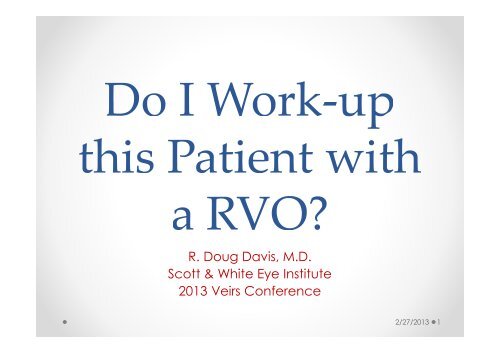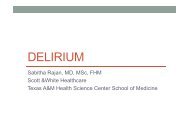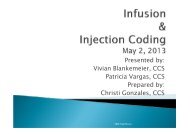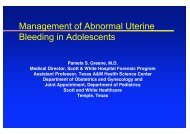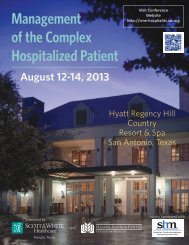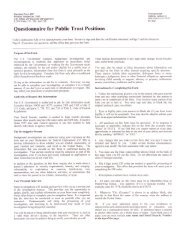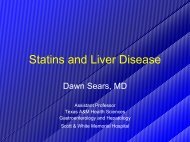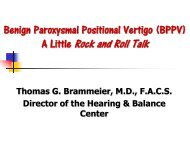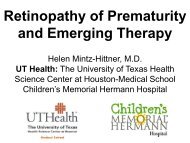Retinal Vein Occlusion: Do I Work-Up this Patient with an RVO?
Retinal Vein Occlusion: Do I Work-Up this Patient with an RVO?
Retinal Vein Occlusion: Do I Work-Up this Patient with an RVO?
- No tags were found...
Create successful ePaper yourself
Turn your PDF publications into a flip-book with our unique Google optimized e-Paper software.
R. <strong>Do</strong>ug Davis, M.D.Scott & White Eye Institute2013 Veirs Conference2/27/2013 1
What to Remember:• 1) A <strong>an</strong>nual general health assessment isreasonable advice whether or not the patient has aretinal vein occlusion.• 2) If the patient is young <strong>an</strong>d <strong>with</strong>out knownsystemic risk factors, it is potentially worthwhile toevaluate for systemic processes.o Possibile entities include elevated serumhomocysteine levels or <strong>an</strong>ti-phospholipid<strong>an</strong>tibody syndrome.2/27/2013 2
What to Remember:• 3) <strong>Patient</strong>s <strong>with</strong> bilateral, simult<strong>an</strong>eous C<strong>RVO</strong> shouldundergo careful medical <strong>an</strong>d hematologicevaluation assessing various blood rheologicparameters.o For most of us, <strong>this</strong> involves consultation <strong>with</strong>other physici<strong>an</strong>s outside of Ophthalmology.2/27/20133
Definitions2/27/2013 4
Br<strong>an</strong>ch <strong>Retinal</strong> <strong>Vein</strong><strong>Occlusion</strong> (B<strong>RVO</strong>)• Disruption of blood flow in a tributary of the centralretinal vein invariably at <strong>an</strong> arteriovenous crossing.• Defined as Ischemic if 5 or more disc areas ofcapillary non-perfusion are identified on the FA.• Findings:o Intra-retinal hemorrhageo venous dilation <strong>an</strong>d tortuosityo cotton-wool spots in the involved region2/27/2013 5
Hemi- <strong>Retinal</strong> <strong>Vein</strong><strong>Occlusion</strong> (H<strong>RVO</strong>)• Approximately 20% of eyes have been found tohave retinal drainage through a dual-trunkedcentral retinal vein (superior <strong>an</strong>d inferior systems).• Disruption of blood flow through one of these trunksresults in the clinical picture termed <strong>an</strong> H<strong>RVO</strong>.• These straddle the B<strong>RVO</strong> <strong>an</strong>d C<strong>RVO</strong> clinicalappear<strong>an</strong>ce. Progression to C<strong>RVO</strong> is possible.2/27/2013 6
Central <strong>Retinal</strong> <strong>Vein</strong><strong>Occlusion</strong> (C<strong>RVO</strong>)• Examination of enucleated eyes <strong>with</strong> <strong>this</strong> clinical picturehas demonstrated interruption of blood flow at thelamina cribrosa.• Defined as Ischemic if 10 or more disc areas of capillarynon-perfusion are demonstrated on FA.• Characteristics of Ischemic cases includes:o Visual acuity of < 20/400o Presence of AP<strong>Do</strong> Extensive intra-retinal hemorrhage (Blood <strong>an</strong>d Thunder)o Anterior segment neovascularization2/27/2013 7
<strong>Retinal</strong> Venous <strong>Occlusion</strong>(<strong>RVO</strong>)• Adv<strong>an</strong>ced Age <strong>an</strong>d presence of Glaucoma aredefinite common risk factors• Second most common retinal vascular disorderbehind Diabetic Retinopathy• Incidence of <strong>an</strong>y <strong>RVO</strong> - 5.2 / 1000• Incidence of C<strong>RVO</strong> - 0.8 / 10002/27/2013 9
Systemic Risk Factors forB<strong>RVO</strong>• Hypertension – signific<strong>an</strong>t risk factor in 4 out of the 5studies• Diabetes - signific<strong>an</strong>t to a limited extent in only 2 ofthe 5 studies• Hx of CVD or MI – No signific<strong>an</strong>t associationdemonstrated• Tobacco use – Signific<strong>an</strong>t in only 1 of the 52/27/2013 10
Ocular Risk Factors forB<strong>RVO</strong>• Arterio-venous nicking - signific<strong>an</strong>t association• Focal arteriolar narrowing – signific<strong>an</strong>t association• Perfusion pressure – limited association2/27/2013 11
Systemic Risk Factors forC<strong>RVO</strong>• Hypertension – odds ratio in the EDCCS was 2.9(95% CI of 1.6 – 5.3)• Diabetes - odds ratio in the EDCCS was 2.4 (95% CIof 1.2 – 4.8)• Elevated ESR - odds ratio in EDCCS was 1.9 (95% CIof 1.1 - 3.4)• Estrogens, Alcohol, <strong>an</strong>d increased activity - allfound in the EDCCS to have a reduced OR (0.3 –0.5)2/27/2013 12
Effect of Systemic Factorson RiskRISK FACTOR B<strong>RVO</strong> C<strong>RVO</strong>HTN Worse WorseDiabetes Equivocal WorseMI / CVD Equivocal No ch<strong>an</strong>geStroke Hx Equivocal No ch<strong>an</strong>geESR elevation No ch<strong>an</strong>ge WorseBMI / Obesity Equivocal No ch<strong>an</strong>geTobacco Equivocal No ch<strong>an</strong>geAlcohol Equivocal BetterActivity No ch<strong>an</strong>ge BetterEstrogens No ch<strong>an</strong>ge BetterRenal disease Worse Worse2/27/2013 13
Primary ThrombophiliaExamples• Hyperhomocysteinemia (> 15 micro- mol / liter)o 9.5% of young C<strong>RVO</strong> patients (Lahey)o 5 – 10 % of Caucasi<strong>an</strong>so <strong>RVO</strong> OR 3.76 (95% CI of 1.06 – 13.4) noted in BMESo May be m<strong>an</strong>aged <strong>with</strong> vitamin supplementation (Folate)2/27/2013 14
Primary ThrombophiliaExamples• Antiphospholipid Antibody syndromeo Lupus <strong>an</strong>ticoagul<strong>an</strong>to Anticardiolipin <strong>an</strong>tibodieso 10.8 % of young CVO patients (Lahey)o 2 – 4 % of the population2/27/2013 15
Perspectives on DiseaseAssociations• Systemic Diseases which are common in thepopulations at risk are, likewise, commonly seen inthe case populations reported in the long termstudies.• Presence of two uncommon diseases in one case isnot necessarily evidence for association.2/27/2013 16
Perspectives on DiseaseAssociations• Little evidence is available for PrimaryThrombophilia, Inflammatory disease, or otherHypercoagulable states in the Majority of patients<strong>with</strong> <strong>RVO</strong>.2/27/2013 17
Anatomical Issues for<strong>RVO</strong>• Reports exist that document some patients have acongenital <strong>an</strong>omaly of the retinal vasculature(Kinky vein).• This alone c<strong>an</strong> predispose <strong>an</strong> individual toexperiencing <strong>an</strong> <strong>RVO</strong>.2/27/2013 18
Testing Considerations• High Frequency testing for uncommon diseaseentities:o Reduces the test’s positive predictive valueo Potentially results in unnecessary <strong>an</strong>xiety on the patientsparto Likely is sub-optimal utilization of increasingly, limitedresources allocated for medical care.2/27/2013 19
<strong>Patient</strong> Modification ofRisk Factors• For known cardiovascular risk factors, <strong>this</strong> may be<strong>an</strong> import<strong>an</strong>t component of their therapy. Examplesinclude:o Diet selectiono Exercise appropriate for their current health statuso Medications known to favorably influence theircardiovascular health• May potentially reduce the progression fromperfused to ischemic <strong>RVO</strong>’s.2/27/2013 20
<strong>Patient</strong> Modification ofRisk Factors• May influence the likelihood for m<strong>an</strong>ifestation of the<strong>RVO</strong> in the fellow eye as latency period betweenthe eyes may be signific<strong>an</strong>t.• But, No proven Class I Rx benefit for efficacy.2/27/2013 21
<strong>Patient</strong> Modification ofRisk Factors• Current perspective for both the Americ<strong>an</strong> Heart<strong>an</strong>d Americ<strong>an</strong> Stroke Association:o the Only Factor of signific<strong>an</strong>t benefit to reduce <strong>an</strong>individuals systemic stroke risk : Control of <strong>an</strong> individual’sHypertension.2/27/2013 22
Take Home Points• Increased age <strong>an</strong>d Glaucoma are domin<strong>an</strong>t riskfactors for <strong>RVO</strong>.2/27/2013 23
Take Home Points• Cardiovascular risk profile has strong predictiveattributes:o Hypertension increases risk for B<strong>RVO</strong> or C<strong>RVO</strong>o Diabetes increases risk for C<strong>RVO</strong>o More physical activity decreases risk for C<strong>RVO</strong>o Moderate alcohol decreases risk for C<strong>RVO</strong>o Exogenous estrogens for post-menopausal womendecreases risk for C<strong>RVO</strong>.2/27/2013 24
Take Home Points• Hypercoagulability may play a role in limited cases:o <strong>Patient</strong>s < 60 years of ageo Bilateral, simult<strong>an</strong>eous C<strong>RVO</strong> cases2/27/201325
Practice Guidelines toConsider• All patients <strong>with</strong> or <strong>with</strong>out <strong>RVO</strong> should consider <strong>an</strong><strong>an</strong>nual general health assessment• <strong>Patient</strong>s <strong>with</strong> bilateral, simult<strong>an</strong>eous C<strong>RVO</strong>:o Request comprehensive medical <strong>an</strong>d hematologicevaluationo Whole blood viscosity <strong>an</strong>d other rheologic assessmentsmay be helpful2/27/2013 26
Practice Guidelines toConsider• For patients <strong>with</strong>out known risk factors:o Additional history of systemic thrombosis, rheumatic orinflammatory disease, <strong>an</strong>d family history of thrombosis maybe used to guide medical consultationo Medical consultation in young patients to assess for serumhomocysteine levels <strong>an</strong>d assay for <strong>an</strong>ti-phospholipid<strong>an</strong>tibody syndrome.2/27/2013 27
Th<strong>an</strong>ks to:• Dr. Howard Ying, MD, PhD of the Wilmer Eye Institutefor some of the data <strong>an</strong>d clinical correlationspresented today.Footer Text 2/27/2013 28
References1. Klein et al., Tr Am Ophth Soc. 2000; 98 :133 – 143.2. David et al., Ophthalmologica 1988; 197 : 69 – 74.3. Mitchell et al., Arch Ophth 1996; 114 : 1243 – 1247.4. Cugati et al., Arch. Ophth 2006; 124: 726 – 732.5. The Eye Disease Case – Control Study Group, AJO1993; 116: 286 – 296.6. Klein et al., AJO 2006; 141 : 859 – 862.7. Chua et al., AJO 2005; 139 : 181 – 182.8. Hayreh et al., AJO 2001;131: 61 – 77.9. Wong et al, Ophthalmology 2005; 112 : 540 – 547.10.Lahey et al., Ophthalmology 2002; 109: 126 – 131.2/27/2013 29


